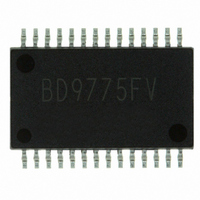BD9775FV-E2 Rohm Semiconductor, BD9775FV-E2 Datasheet - Page 11

BD9775FV-E2
Manufacturer Part Number
BD9775FV-E2
Description
IC REG SW STEP DOWN HE 28-SSOP
Manufacturer
Rohm Semiconductor
Type
Step-Down (Buck)r
Specifications of BD9775FV-E2
Internal Switch(s)
No
Synchronous Rectifier
Yes
Number Of Outputs
2
Current - Output
400mA
Frequency - Switching
100kHz
Voltage - Input
6 ~ 30 V
Operating Temperature
-40°C ~ 85°C
Mounting Type
Surface Mount
Package / Case
28-SSOP
Power - Output
640mW
Mounting Style
SMD/SMT
Lead Free Status / RoHS Status
Lead free / RoHS Compliant
Voltage - Output
-
Lead Free Status / Rohs Status
Lead free / RoHS Compliant
Other names
BD9775FV-E2TR
●Notes for use
© 2011 ROHM Co., Ltd. All rights reserved.
BD9775FV
www.rohm.com
1)
2)
3)
4)
5)
6)
7)
8)
9)
10) Timing resistor and capacitor
11) The Dead time input voltage has to be set more than 1.1V.
12) The energy on DTC1(8pin)and DTC2(9pin)is discharged when CTL1(12pin)and CTL2(13pin)are OFF, respectively, or
Absolute maximum ratings
Use of the IC in excess of absolute maximum ratings such as the applied voltage or operating temperature range may
result in IC deterioration or damage. Assumptions should not be made regarding the state of the IC (short mode or open
mode) when such damage is suffered. A physical safety measure such as a fuse should be implemented when use of
the IC in a special mode where the absolute maximum ratings may be exceeded is anticipated.
GND potential
Ensure a minimum GND pin potential in all operating conditions. In addition, ensure that no pins other than the GND pin
carry a voltage lower than or equal to the GND pin, including during actual transient phenomena.
Thermal design
Use a thermal design that allows for a sufficient margin in light of the power dissipation (Pd) in actual operating
conditions.
Inter-pin shorts and mounting errors
Use caution when orienting and positioning the IC for mounting on printed circuit boards. Improper mounting may result
in damage to the IC. Shorts between output pins or between output pins and the power supply and GND pin caused by
the presence of a foreign object may result in damage to the IC.
Operation in a strong electromagnetic field
Use caution when using the IC in the presence of a strong electromagnetic field as doing so may cause the IC to
malfunction.
Thermal shutdown circuit (TSD circuit)
This IC incorporates a built-in thermal shutdown circuit (TSD circuit). The TSD circuit is designed only to shut the IC off
to prevent runaway thermal operation. Do not continue to use the IC after operating this circuit or use the IC in an
environment where the operation of the thermal shutdown circuit is assumed.
Testing on application boards
When testing the IC on an application board, connecting a capacitor to a pin with low impedance subjects the IC to
stress. Always discharge capacitors after each process or step. Ground the IC during assembly steps as an antistatic
measure, and use similar caution when transporting or storing the IC. Always turn the IC's power supply off before
connecting it to or removing it from a jig or fixture during the inspection process.
Common impedance
Power supply and ground wiring should reflect consideration of the need to lower common impedance and minimize
ripple as much as possible (by making wiring as short and thick as possible or rejecting ripple by incorporating
inductance and capacitance).
Applications with modes that reverse VCC and pin potentials may cause damage to internal IC circuits.
For example, such damage might occur when VCC is shorted with the GND pin while an external capacitor is charged.
It is recommended to insert a diode for preventing back current flow in series with VCC or bypass diodes between VCC
and each pin.
Timing resistor (capacitor) connected between RT (CT) and GND, has to be placed near RT (CT) terminal 3pin (4pin).
And pattern has to be short enough.
Also, the resistance between DTC and VREF is used more than 30kΩ to work OCP function reliably.
VCC(14pin)is OFF (UVLO activation). However, it is considerable to occur overshoot when CTL and VCC are turned
on with remaining more than 1V on the DTC.
Countercurrent
prevention diode
Fig.14
11/14
Vcc
Pin
Bypass diode
Technical Note
2011.05 - Rev.A






